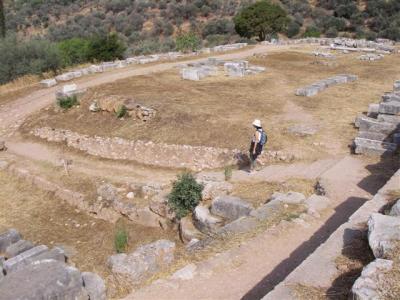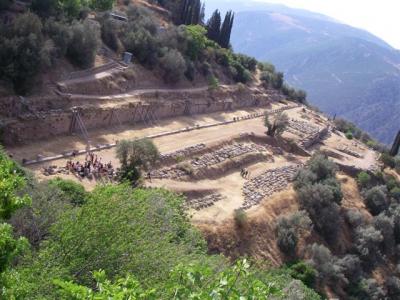The ancient city of Delphi is cut in half by the highway. We had only gone to the larger portion of the city above the road with the tour group. This morning we were up bright and early to go see the section below the highway, which holds the gymnasium, the temple of Athena, and a few treasuries.
In yesterday’s post we mentioned that in the early days of the oracle, the goddess Gaia was the one communicating the messages, and that in later years it was Apollo who spoke to the people. There is actually a story in Greek mythology that explains the change. Gaia, the earth goddess, established the oracle and sent her daughter, Python, the serpent, to protect it. Python became enemies with the god Apollo, son of the great Zeus. Apollo rode up the mountain to Delphi on a dolphin’s back (Delphi means dolphin in Greek) and slew Python. Apollo began a tradition called the Pythian Games to celebrate his victory over Python. Contestants from all areas of Greece gathered in Delphi every four years to face off, in hopes of winning the sacred prize of a crown of laurel (bay leaves).
We have our doubts as to whether all of the information in that story is historically accurate, but we can say that that the Pythian Games were definitely real. Historians believe they began in the 6th century BC, and that they were the pre-cursor to the Olympic Games. The tradition of the Pythian Games continued until the city of Delphi was essentially closed by the Roman/Byzantine emperor. When the Olympic Games began, they were held in different years than the Pythian Games. Being as they were both on a four year cycle, there was never a conflict.
The Pythian Games initially started out as a musical competition. Later poetry, acting, and painting were added. These contests were held in the theater pictured yesterday. Eventually sports were also added, as was chariot races. Some of the sporting competitions were held in the stadium mentioned yesterday, some in the gymnasium we were about to enter into today. Just like the Olympics today, the Pythian Games were a huge deal in their day. While there wasn’t a monetary prize, winning the laurel wreath carried tremendous prestige. Cities supported their representatives with full force. Tons of spectators went to Delphi to watch the games, bringing a lot of wealth into the city. For several weeks before and after the games (and of course, during), there was a pan-Hellenic cease fire so that people could travel safely to Delphi and back. There were huge festivals and ceremonial rituals that went on for several days before the games actually began.
We walked over to the ruins, passing by two ancient drinking fountains, one from the early classical era and one from the Roman age. Delphi is on a river, and they channeled the river water into the fountains. It doesn’t look so good for drinking out of these days. We looked down at the gymnasium. Yup. It looks like the field at every school gym. It is a large, mostly flat area, complete with an oval dirt track. Beyond the oval track is a straight stretch of track, probably for contests like the high jump. The rest of the flat ground has groupings of stone blocks neatly laid out, presumably the remains of assorted gym accoutrements.


Below the gymnasium is an area that houses the temple of Athena and the treasuries. The temple of Athena is probably Continue reading →
